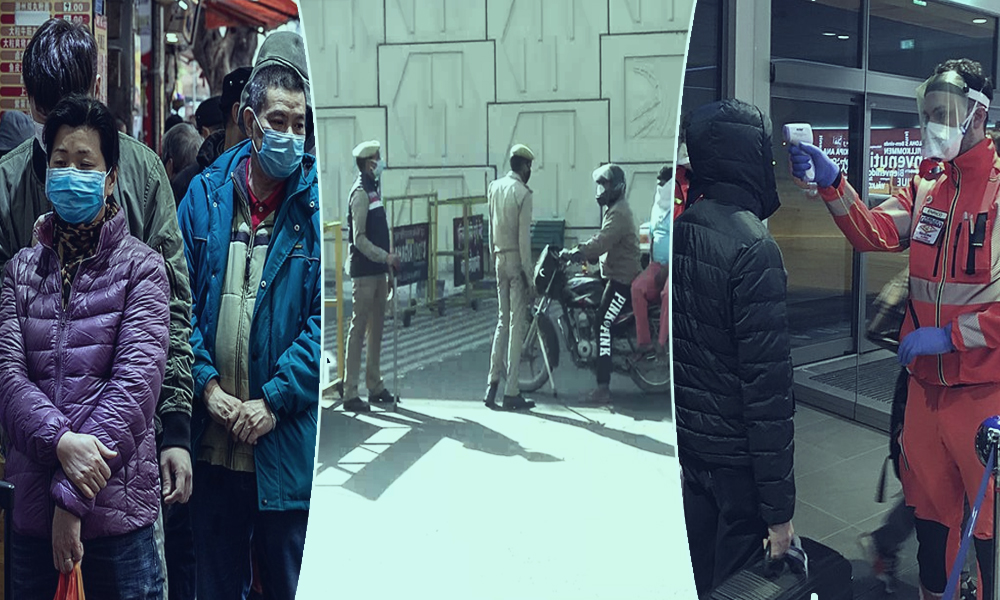
Image Credits: Wikimedia, Economic Times
Is India's COVID-19 Lockdown Biggest & One Of Harshest In World?
India, 31 March 2020 11:10 AM GMT | Updated 31 March 2020 11:18 AM GMT
Editor : Prateek Gautam
A free soul who believes that journalism, apart from politics, should stand for social cause and the environment.
A 21-day lockdown to force India's 1.3 billion people to stay indoors should have been implemented after reviewing the on-ground situation, the potential impact of such a decision, and inevitably, a contingency plan.
"I apologize to the people of the country because of the inconvenience caused to them. I know some of you would be angry with me for taking such steps," said Prime Minister Narendra Modi while addressing the nation during his monthly radio programme, Mann Ki Baat.
What can be considered ironical in the prevailing situation is the fact that Modi's Mann Ki Baat had hit the right chord with the nation, this time.
A 21-day lockdown to force India's 1.3 billion people to stay indoors, in an attempt to tackle the spread of the novel coronavirus, should have been implemented after reviewing the on-ground situation, the potential impact of such a decision, and inevitably, a contingency plan.
With two-thirds of the population living in poverty and poor public health care infrastructure, an unplanned nationwide lockdown was sure to take a toll on the lives of the underprivileged.
The public transportation system including the Indian Railways and the interstate bus services were halted in one day, without providing a window for the citizens to plan their necessary movement. This also included the airlines suspending domestic flights.
PM Modi's announcement of the lockdown was heavily criticised since it failed to detail the plan of action that was going to follow the announcement.
For instance, soon after the lockdown was announced, ill-informed citizens of the country overcrowded the supermarkets and grocery stores, resorting to panic-hoarding of the essentials which plainly defied the instruction of social distancing.
The Prime Minister, later in the day, took to Twitter to respond to the viral pictures and videos of over-crowded stores across the nation. In a tweet, he ensured that the respective state governments would work towards availing the essentials which included food and medicines.
By converging around shops, you are risking the spread of COVID-19.
— Narendra Modi (@narendramodi) March 24, 2020
No panic buying please.
Please stay indoors.
I repeat- Centre and State Governments will ensure all essentials are available. https://t.co/bX00az1h7l
Things could have been better only if the Prime Minister knew that the lives of those worst-affected by the lockdown are still devoid of the blessing of digitalisation.
Later, as the country geared up to enter into its first day of the lockdown, social media exploded with images and videos of ruthless policemen in several states resorting to violence with lathis in a bid to teach a lesson to the lockdown violators.
Heart-wrenching stories of food delivery agents being stopped and beaten up made rounds on social media and then garnered national attention on the inhumanness of the state police departments in handling the situation.
The incidents that occurred in the next few days clearly pointed at the central and the state governments being caught off-guard due to an announcement that was precariously made.
Tens of thousands of migrant workers engaged in the unorganised sector, who survive on the daily wages, unable to work and provide for themselves, stuck in the cities amid the government shutdown of all buses and trains, resorted to walking hundreds of kilometres to return to their home states.
This mass exodus of the migrant workers, on foot, has come to be known as the biggest human migration on foot, after partition.
The arduous journey of hundreds of kilometres, without food and water, started taking a toll on the lives of such workers.
A number of news organisations reported on the death of a number of migrant workers while other reports highlighted the failure and blame-game of the state governments in dealing with the unexpected exodus.
"We will die of walking and starving before getting killed by corona," said migrant worker Madhav Raj, 28, as he walked along the road in Uttar Pradesh, reported Al Jazeera.
What was being called as the world's biggest lockdown now has also become the world's strictest COVID-19 lockdown.
Appropriate plans for people with health conditions, the elderly, pregnant women, quarantined individuals that require hospital-visits were missed.
Five days into the lockdown, when such incidents started cropping up, governments in a few states came up with an idea to issue passes for hassle-free travel and several other emergencies.
Such extreme measures were taken during a situation when the number of individuals infected with the novel coronavirus is still in the nascent stage and community transmission has not yet been detected.
COVID-19 Lockdown In Other Countries:
China
Reportedly, in mid-January, the Chinese authorities imposed unprecedented measures to contain the virus, the first country implementing the idea of a nationwide lockdown.
Movement in and out of Wuhan, the epicentre of the COVID-19 outbreak, and 15 other cities in Hubei province which had become the hotbed of the outbreak were stopped.
Flights and trains were suspended, and roads were blocked to curtail any kind of movement which would further the spread of the virus.
Soon after, people in other cities were instructed to stay at home, practise social distancing and venture out only in case of emergencies.
The New York Times reported that some 760 million people, roughly half the country's population were asked to stay indoors.
Over the course of two months, China has successfully contained the spread of the virus and there have been reports of buses plying in and out cities, cabs being run with precautionary measures, flights and trains suspended in certain areas.
The World Health Organisation, too, congratulated China as "perhaps the most ambitious, agile and aggressive disease containment effort in history".
Early detection and isolation strategy worked well with a country like China which had made planned efforts in detecting and treating the patients first and then keeping the rest of the country confined under lockdown.
Italy
One of the countries to be worst-affected by the COVID-19 outbreak is Italy.
With over a lakh confirmed cases of the novel coronavirus, the country is grappling to curb the spread of the virus and hence announced a total lockdown.
Italy had a structured quarantine and lockdown announcement.
The initial quarantine measure was imposed on February 21 in a region in the north and covered only 50,000 people.
It was only on March 9 that the government announced a national lockdown, confining 60 million people indoors.
Travel is still permissible in Italy, however, only in "urgent, verifiable work situations and emergency or health reasons."
Also, the airports remain operational but those wanting to travel need to comply with the requisite documentation.
According to the reports, Italy instituted a pass system where people can take a bus or a flight depending on need.
As of March 31, Italy had 11,591 COVID-19 deaths compared to India's 47.
United States
The United States has, now, become the epicentre of the COVID-19 crisis with more than 160,000 cases, almost double the number in China.
President Donald Trump, on Sunday, March 29 extended the initial 15-day period of social distancing through April 30.
The federal guidelines recommended people against large gatherings and have also urged the elderly and people with health conditions to stay indoors.
People have also been urged to work from home when possible and have been instructed to avoid restaurant, bars and non-essential travel and shopping trips.
Bangladesh
Bangladesh's Prime Minister Sheikh Hasina, on March 25, appealed the citizens to stay at home and avoid any gathering to slow the transmission of the virus.
In a televised address, she urged the thousands of Bangladeshis who worked abroad and had recently returned to the country to self-quarantine themselves for 14 days.
Reportedly, unlike India, Bangladesh allowed a window before the announcement for the migrant workers to comfortably reach their natives.
"Many people have become unemployed because of the coronavirus epidemic. We need to stand beside them. Members of the lower-income groups will receive assistance in their own villages...homeless and landless people will get free housing, food for six months and cash incentives, " she said in her address.
The country declared a 10-day "holiday" during which it has suspended all transport links to prevent the COVID-19 transmission.
Sri Lanka
Sri Lanka also finds a place in the list of countries under strict COVID-19 lockdown.
However, according to the reports, the country initially declared a holiday as a warning, and then imposed the lockdown.
Reportedly, Sri Lanka has been aggressively monitoring and quarantining the arrivals, chasing down the contacts to prevent further transmission of the virus.
In what is being termed as a surgical lockdown, the Sri Lanka government ran special trains and buses to ferry workers who wanted to leave the capital before lockdown, following a carefully-crafted lockdown plan to avoid panic and chaos.
 All section
All section













